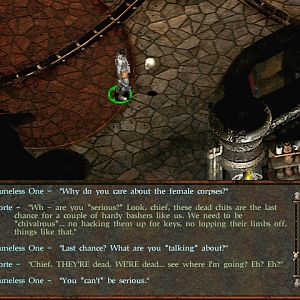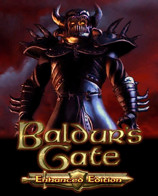-

- Forums
- Chatrooms
- Gallery
- Gameplay Videos
- Upload
- Articles
- Mod Reviews
- Shop SP: Games, Movies, Books

|
|
COMBAT
Proper Placement of your Troops
If you have a dedicated spell caster like a Mage, you have to make provision for interjecting other party members between the monsters and your spell caster. In other words, you need to place characters at the front, at both flanks, and maybe the back as well, in the event that you get surrounded. So something that merits consideration is developing not just 3 bona fide warrior characters, but also characters who can act as credible flank characters. In my instance, it is my Priest and Bard. My arrangement was:
Ninja - Valkyrie - Monk
Priest Bishop Bard
The Priest and Bard are not quite up to acting as credible flank guards during the early going, or at least not during the early going against certain monsters. So early on, for certain fights that I can see coming, I'll often back myself into a nook or cranny so that the monsters can only reach my front 3 warriors. But once I get to a certain level of advancement, and have acquired certain items, my Priest and Bard hit their stride as flank guards.
Always Keep your Buffs up
There are four long-lasting spell buffs that can be cast outside of combat, and should always be maintained: Armor Plate, Enchanted Blade, Missile Shield, and Magic Screen. They last long enough so that if you manage things well, chances are you will have completely recouped your mana by the time one of them wears off, allowing you to simply put it back up and resume. As such, you can often go on and on without ever having to rest and risk monster ambushes as long as you can keep your buffs up in a cycle.
Armor Plate of course increases your armor class. Enchanted Blade increases your chances of penetrating the monsters' armor with your weapons, and your damage. Missile Shield provides a chance of deflecting missile fire from your enemies.
Magic Screen provides a long lasting bonus to all of the characters' resistances (earth, air, fire, water, divine, mental). The additional points to Magic Screen will be elaborated soon.
Status Effects
There are a number of status effects that monsters and characters may inflict on each other, like poisoning, insanity, critical strike (instant death), etc. This always involves a random dice roll, but one that is modified by the relative levels of the characters and the monsters. A character that is higher level than the monsters will have an easier time inflicting status effects on the monsters, and have an easier time resisting status effects by the monsters. The reverse is also true.
This dynamic applies to status effects inflicted by weapons (e.g. poisoning from a Vorpal Blade) and to status effects inflicted by spells (e.g. Insanity, Blinding Flash).
Weapon Choices
There are a number of considerations for choosing your weapons.
Damage Range - This is a no-brainer, but I may as well mention it. The better the damage range of your weapon, the better you'll do in combat.
Status Effects - Ideally, a weapon should inflict status effects as well. Keep in mind that this is subject to the dynamic that I described above. For example, Fang has a 10% chance of insta-killing its target and Nunchakas have a 15% chance of knocking out their targets. This does not mean that strikes with Fang will always kill 10% of the time and that Nunchakas will always knock out 15% of the time. What it means is that Fang will have a 10% chance of triggering a dice roll to insta-kill the monster that is modified by the respective levels of the character wielding Fang and the targeted monster. Nunchakas, 15% chance of triggering a dice roll to knock out the monster that is modified by the respective levels of the character wielding the Nunchakas and the targeted monster. Even so, you will still do noticeably better in combat with weapons that pack status effects in comparison with weapons that inflict vanilla damage.
Initiative - Some items have an initiative bonus, and this confers more than one benefit. One is that you get to attack sooner than the other monsters. The other is that a character can attack more times, and have more swings per attacks, with a weapon that has a higher initiative bonus. Keep in mind that most two-handed weapons have an initiative penalty, but they have their own benefits as we'll see just below.
Two sets of weapons - One set weapon for when the monsters are right next to your character, and another set for when they're at a longer distance. For instance, my Monk will fight with his bare fists for close-up combat, but also has a Bo as his secondary weapon that can strike monsters at extended range. The point behind all this is that it often saves you the trouble of having to move up to monsters to attack again. If you have to move up to the monsters, your characters will have at best half of their attacks and swings per round, and at worst none at all. If you have secondary weapons that can strike at extended (e.g. polearms) or long range (e.g. missile weapons), you can at least use your full set of attacks for the round when the monsters are at extended range. Likewise, if my front 3 tanks kill the monsters in front of them, but there are still monsters right next to my Priest and Bard, my warriors can simply switch to their secondary weapons and begin attacking immediately. This is why extended-range weapons like spears and lances shouldn't be discounted entirely. Yes, they have an initiative penalty, but they also provide more flexible options during combat.
Dual-Wield is usually better than Shields - Especially when both your main-hand weapon and your off-hand weapon pack nasty status effects. For example, my Valkyrie will wield the Diamond Eyes in her off-hand, which will often paralyze the targeted monster. This then sets up the monster for massive damage from the main-hand Ivory Blade. This dynamic far outweighs the armor class bonus from wearing a shield. There are exceptions of course. The *Light Shield* helps transform what would otherwise be a rather weak and vulnerable priest into a credible fighter and flank guard.
Protecting yourself against Magic
First, always have Magic Screen in place. It is a long-lasting buff that provides a bonus to all resistances, and endures both during combat and outside of combat.
There are 2 other protective spells. Elemental Shield provides bonuses to earth, air, fire, and water resistance. Soul Shield provides bonuses to divine and mental resistance. These spells only last for a number of rounds (depending on which power level you cast it at and also whether you have the Power Cast skill or not) within combat itself. They cease working either when their rounds have run out, or combat itself ends.
They will stack with the bonuses provided by Magic Screen. Also keep in mind that magic is subject to the same caster level vs. target level dynamic that I described above for status effects coming from weapons. So ... if the monsters are either few and/or lower level than you, Magic Screen will very often suffice by itself. On the other hand, if you're faced with powerful spell casting monsters who are either numerous and/or higher level than you, then it becomes advisable to cast Elemental Shield and/or Soul Shield in order to stack your bonuses with Magic Screen.
Also, if you can physically outmatch your enemies, Magic Screen + Elemental Shield and/or Soul Shield is a great way to reduce the battle to pure physical combat where you simply cut them down one by one.
Notice also that some items provide resistance bonuses. For example, an Amulet of Healing has a +30% resistance. This does not mean that a character wearing an Amulet of Healing is flat-out immune to attacks based on divine magic 30% of the time. The 30% is a round-about way of saying it provides an upwards adjustment for the character wearing the amulet when the die roll based on level vs. level dynamic comes into play. If you still need to wrap your head around this, think of it along the lines of how some items in the Dungeons and Dragons rules sets provide bonuses to saving throws. So it certainly doesn't hurt to be on the lookout for items that provide resistance bonuses.
Casting Offensive Magic
First, heed my advice about making sure characters get spells from all the realms. There's more than one point to this.
When you start fighting monsters, r-click on them. You'll get some information on them, including what their resistances are. This can be valuable, since it affords you an opportunity to ascertain what their relative weaknesses are, and select your spells accordingly.
Of course, you will run into some monsters that seem stacked with resistances across the board. The Power Cast skill is the key to overcoming this. The higher your Power Cast skill, the more likely your spells will pierce their resistances. Since I have my hybrid characters concentrate on attributes other than the 100 Intelligence needed to get Power Cast, I often have them cast utility spells like Chameleon, Detect Secrets, Elemental Shield, Soul Shield, etc. This is not to say that I don't have them cast offensive spells once in a while when the situation warrants it. But when I need to get the job done in a pinch, it's my Bishop who can cast any offensive spell in the book, and any one of them empowered by the Power Cast skill.
One more thing, lingering-damage spells and spells that inflict status-effects are preferable to straight damage spells. Many monsters in Wizardry 8 have ridiculous hit points, so a straight Fireball or Iceball isn't going to do much to impress. Instead, try a spell that inflicts damage over the long haul like Firestorm or Acid Bomb so that the damage will add up over the long haul. Or you can try spells that inflict status effects, like Death Cloud, or Prismic Chaos. Another possibility is spells that inflict both damage and status effects, like Blizzard and Toxic Cloud.


